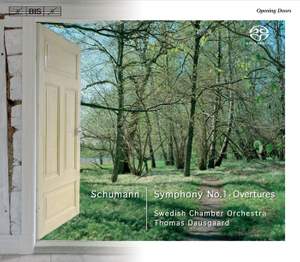Schumann - Symphony No. 1 & Overtures
Swedish Chamber Orchestra, Thomas Dausgaard
Right from the opening fanfares, there's a sense of joy and exhilaration, and the openness of the orchestral textures brings freshness and clarity. The ensemble’s lithe flexibility is used to... — More…
-
Gramophone MagazineMay 2008Editor's Choice
Downloads
What are FLAC and MP3?Contents
Schumann: Symphony No. 1 in B flat major, Op. 38 'Spring'
- Swedish Chamber Orchestra
- Thomas Dausgaard
- Recorded: December 2006
- Recording Venue: Orebro Concert Hall, Sweden
I. Andante un poco maestoso - Allegro molto vivace
II. Larghetto -
III. Scherzo. Molto vivace
IV. Allegro animato e grazioso
Schumann: Die Braut von Messina: Overture, Op. 100
- Swedish Chamber Orchestra
- Thomas Dausgaard
- Recorded: August 2007
- Recording Venue: Orebro Concert Hall, Sweden
Excerpt,
- Swedish Chamber Orchestra
- Thomas Dausgaard
- Recorded: December 2006
- Recording Venue: Orebro Concert Hall, Sweden
Overture
Schumann: Symphony in G Minor, Anhang A3, "Zwickau", I. Moderato - Allegro
- Swedish Chamber Orchestra
- Thomas Dausgaard
- Recorded: October 2006
- Recording Venue: Orebro Concert Hall, Sweden
I. Moderato - Allegro (First manuscript edition)
Schumann: Overture, Scherzo, and Finale, Op. 52
- Swedish Chamber Orchestra
- Thomas Dausgaard
- Recorded: March 2005
- Recording Venue: Orebro Concert Hall, Sweden
I. Overture: Andante con moto - Allegro
II. Scherzo. Vivo
III. Finale. Allegro molto vivace






